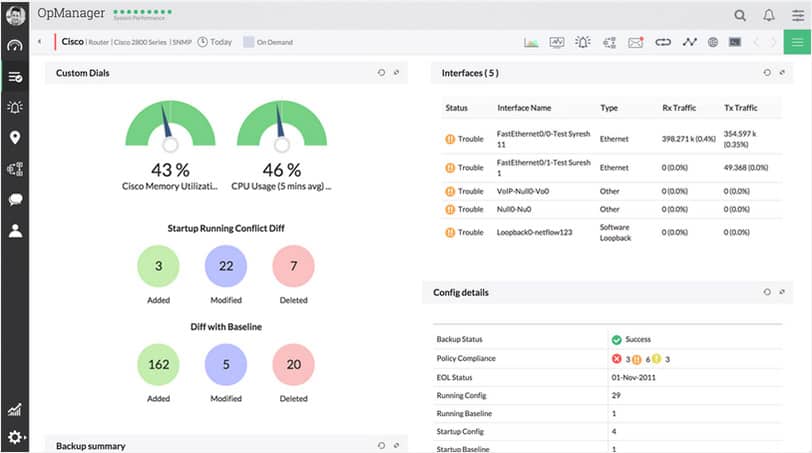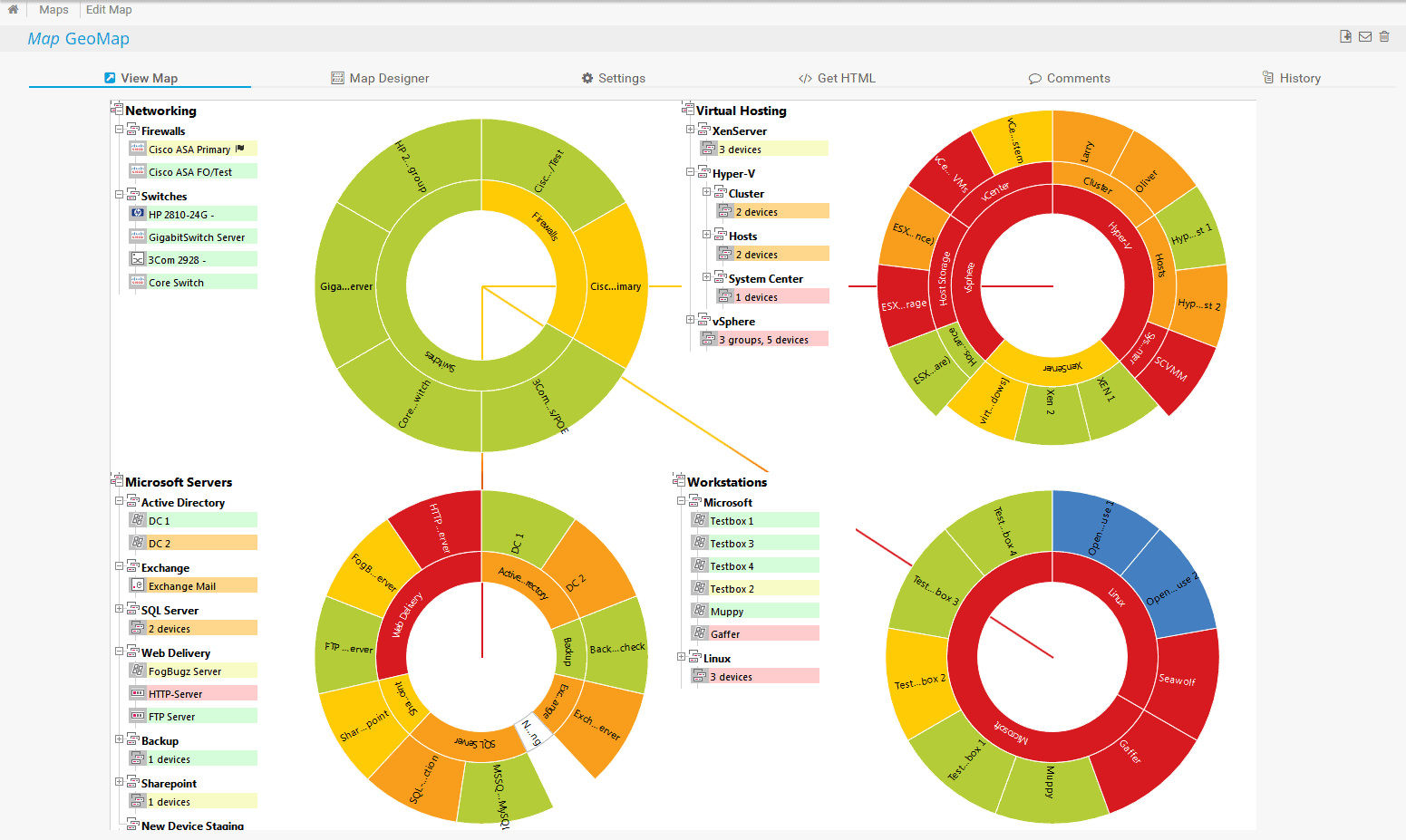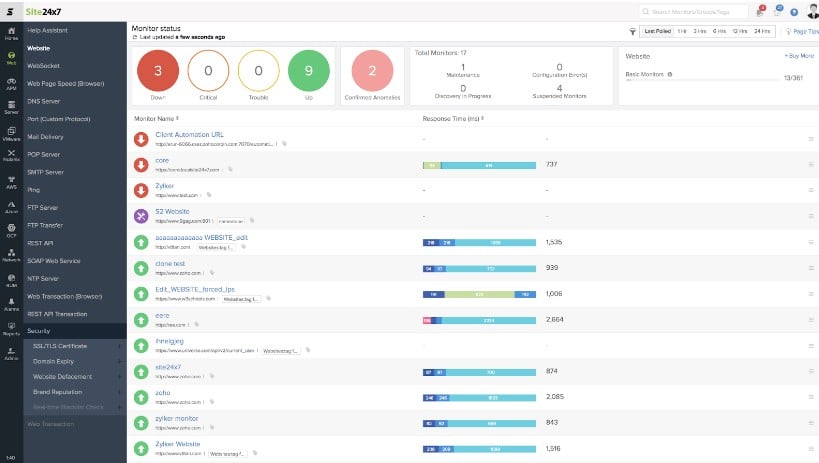We may earn a commission if you make a purchase through the links on our website.
The Best Nagios Alternatives for Server, Application and Network Monitoring
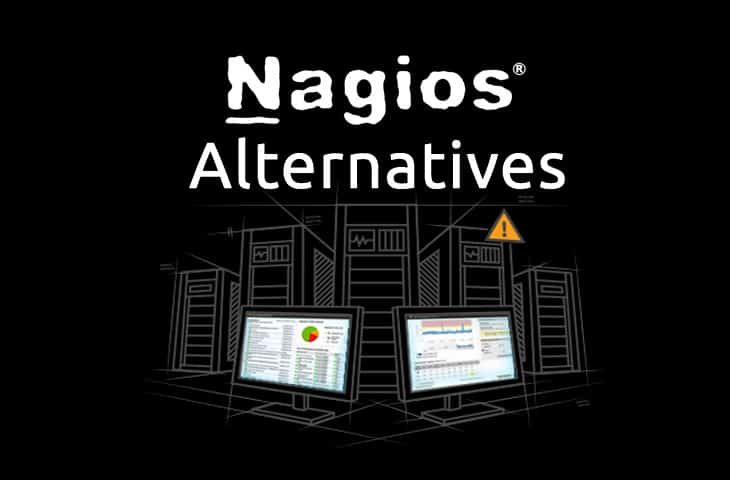
UPDATED: September 6, 2024
Nagios is a great tool for Server and Application monitoring and keeping an eye on your infrastructure and organization. For being Open Source and widely available for multiple operating systems, Nagios can sometimes have its limitations compared to other commercially available options.
We'll discuss some of the best Nagios Alternatives for server and network monitoring for your infrastructure, along with some in-place replacements that make it seamless to migrate.
Here is our list of the top Nagios Alternatives:
- ManageEngine OpManager – EDITOR'S CHOICE A network monitoring package that covers physical and virtual systems. Available for Windows Server and Linux. Get a 30-day free trial.
- Paessler PRTG – FREE TRIAL This full-stack monitoring package goes a little further than Nagios because it includes bandwidth analysis, which Nagios has split off into a separate package. Available for Windows Server or as a SaaS package. Get a 30-day free trial.
- Site24x7 – FREE TRIAL This cloud platform offers packages of system monitors that provide network, server, application, and Web asset monitoring services and also log collection. Access the 30-day free trial.
- Progress WhatsUp Gold A network performance monitor that can be expanded by add-ons to monitor servers and applications as well. Runs on Windows Server.
- Zabbix A free monitoring package that watches over networks, servers, and applications and is a close rival to Nagios Core. Runs on Linux.
- OpenNMS A useful, free network monitoring package that can be expanded by plugins. Offered in free and paid versions, this system runs on Linux.
Common issues that have arisen from folks using Nagios are things such as Auto-discovery of services and applications being used without additional configuration and add-on's being thrown into the mix.
Gartner even had an article on the matter than went into some detail about why folks should get rid of it altogether and look for a better supported software, in case your “talented engineer” decides to leave the company, you won't have a mess on your hands trying to figure out how to upgrade and config a Nagios instance.
Regardless of why your looking for an alternative to Nagios, we've detailed a list of the best network monitoring software that can replace Nagios in your environment. Some of these are Free, others are Paid and commercially supported, which we highly recommend in any production environment. We've been in many situations where having a support contract has saved us hours on end in troubleshooting and misconfiguration of the software.
The Best Alternatives to Nagios
Our methodology for selecting a Nagios alternative
We reviewed the market for server, application, and network monitoring tools like Nagios and analyzed options based on the following criteria:
- Full stack monitoring with live data collection
- Performance monitoring that collects device activity information for network devices and endpoints
- Time-series graphs that show recent performance
- Root cause analysis that links together performance with resource availability
- Alerts for performance problems
- A free trial for a risk-free assessment opportunity or free tool
- Value for money from a paid tool that provides full monitoring capabilities at a reasonable price or a free tool that is worth using
With these selection criteria in mind, we identified a range of system monitoring tools that fully rival Nagios XI and also free systems that match or beat Nagios Core.
This is a quick list of Server and Application monitoring software that can be used in place of Nagios in your environment.
1. ManageEngine OpManager – FREE TRIAL
ManageEngine OpManager is another choice for switching out an open-source software and moving to a commercial grade software. As we've mentioned about in the SolarWinds description, one of the main issues we have is getting proper support and not having to install several other applications in order to do the job of what 1 installation should do.
Key Features:
- Network & Server Monitoring: Monitor network infrastructure and server performance to ensure optimal operation and identify potential issues.
- Bandwidth Usage and Analysis: Analyze bandwidth consumption and detect configuration changes that could impact network performance.
- Firewall Event Log Management: Manage firewall event logs to enhance security and identify potential threats.
- Seamless Integration: Integrates well within the ManageEngine ecosystem, enabling smooth interoperability with other ManageEngine products.
Why do we recommend it?
ManageEngine OpManager presents a compelling option for transitioning from open-source software to a commercial-grade solution. With its comprehensive network and server monitoring capabilities, OpManager streamlines the monitoring process and ensures proper support without the need for multiple installations. While it may lack the ability to import Nagios scripts, OpManager compensates with its robust feature set and seamless integration within the ManageEngine ecosystem.
We did not see anything on their Site in regards to importing Nagios scripts and this could prove to be cumbersome when trying to migrate over. SolarWinds still has the advantage over OpManager in this regards, but if you would like to read a detailed review of ManageEngine OpManager, you can see it here!
Who is it recommended for?
OpManager is recommended for organizations seeking a reliable network and server monitoring solution with extensive capabilities. It caters to businesses looking to transition from open-source software to a commercial-grade platform without compromising on functionality. Additionally, OpManager's bandwidth usage and analysis features make it suitable for IT professionals and system administrators tasked with optimizing network performance and resource utilization. However, users should be prepared to invest time in exploring the full range of options available within the ManageEngine software suite.
Pros:
- Comprehensive Monitoring Capabilities: OpManager offers robust network and server monitoring capabilities, including bandwidth consumption and application-level resource monitoring.
- Multi-Channel Alerting: Supports multiple alerting channels, including email, SMS, and webhooks, ensuring timely notifications of critical events.
- Integration with ManageEngine Ecosystem: Seamlessly integrates with other ManageEngine products, facilitating centralized management and administration.
- Bandwidth and Resource Monitoring: Provides detailed insights into bandwidth and resource consumption at both the network and application levels, enabling proactive optimization.
- Reliable Support: Backed by ManageEngine's reliable support infrastructure, ensuring prompt assistance and resolution of issues.
Cons:
- Learning Curve: Users may require time to fully explore and leverage all the features and functionalities offered by the ManageEngine software suite.
- Extensive Featureset: The solution includes a vast featureset that will take substantial time to fully explore all the options available.
- Limited Import Functionality: Lacks the ability to import Nagios scripts, potentially complicating the migration process for users transitioning from Nagios to OpManager.
See more information and start a 30-day free trial.
EDITOR'S CHOICE
ManageEngine OpManager is our top pick for a Nagios alternative because this system provides you with network device and server monitoring. You don’t get network traffic analysis with OpManager, but then you don’t with Nagios XI either. One element that Nagios offers that you don’t get from OpManager is application monitoring. You can match that functionality by adding ManageEngine Applications Manager to OpManager. The OpManager tool is particularly strong at network monitoring and it will sweep the network to discover all the equipment connected to it. This includes network devices, office equipment, and endpoints. All a device needs in order to get included in the OpManager hardware documentation system is an SNMP agent. The package creates a hardware inventory and will also generate a network topology map. The package provides continuous monitoring of network devices and servers, raising alerts if problems are detected.
Download: Get a 30-day free trial
Official Site: manageengine.com/network-monitoring/
OS: Windows Server, Linux, AWS, and Azure
2. Paessler PRTG – FREE TRIAL
Paessler PRTG is another fairly familiar software package in the server and application monitoring world with its flexible offerings in terms of capabilities and functionality. PRTG has a nice graphical user interface and is fairly easy to use when it comes to getting setup and moving fairly quickly.
Key Features:
- Customizable and Flexible Interface: Tailor your monitoring experience with PRTG's customizable and flexible interface, allowing you to create custom views and reports effortlessly.
- Flexible Alerting System: Receive timely alerts via SMS, email, and third-party integrations like Slack, ensuring prompt notification of any issues or anomalies.
- Distributed Monitoring Capability: Ensure comprehensive coverage across distributed environments with PRTG's distributed monitoring capability, enabling you to monitor networks, servers, applications, and more from multiple locations.
- Network Maps and More: Visualize your network topology and infrastructure with network maps, gaining insights into network performance and connectivity at a glance.
Why do we recommend it?
Paessler PRTG stands out as a reliable and flexible software package in the server and application monitoring realm, offering a range of capabilities and functionalities. We recommend PRTG for its user-friendly graphical interface and ease of setup, allowing users to quickly get started and navigate through monitoring tasks efficiently. With PRTG's customizable and flexible interface, users can tailor their monitoring experience to suit their specific needs and preferences. Additionally, PRTG's distributed monitoring capability ensures comprehensive coverage across complex infrastructures, enabling users to monitor networks, servers, applications, and more with ease.
PRTG Does Not have the Nagios script Import feature that SolarWinds has but has a nice Template system and Auto Discovery system that will allow you to setup devices in an easy manner.
Who is it recommended for?
We recommend Paessler PRTG to IT professionals, system administrators, and businesses seeking a comprehensive yet user-friendly server and application monitoring solution. It caters to users of all skill levels, from beginners to advanced users, providing essential monitoring capabilities for effectively managing IT infrastructures. PRTG is ideal for businesses looking for a flexible monitoring solution that can adapt to their evolving needs and scale with their growth. Whether you're managing a small office network or a large enterprise infrastructure, PRTG offers the flexibility, scalability, and reliability to meet your monitoring requirements and drive operational efficiency.
Pros:
- User-Friendly Interface: PRTG features a user-friendly graphical interface that makes it easy to set up and navigate through monitoring tasks, even for beginners.
- Drag-and-Drop Editor: Build custom views and reports effortlessly with PRTG's drag-and-drop editor, enhancing usability and productivity.
- Wide Range of Alert Mediums: Receive alerts via SMS, email, and third-party integrations into platforms like Slack, ensuring prompt notification of any issues or anomalies.
- Freeware Version Available: PRTG offers a freeware version, allowing users to experience its monitoring capabilities at no cost.
Cons:
- Lacks Native Nagios Script Import Functionality: PRTG does not have the native functionality to import Nagios scripts into the program, which may be a limitation for users accustomed to Nagios environments. However, it offers a template system and auto-discovery system to simplify device setup and configuration.
PRTG contends nicely with the others from above, but as mentioned above, lacks the native functionality to import Nagios scripts into the Program. Check out more about PRTG at their official site and learn about their full Feature Set there. You can start of by downloading a 30-day free trial from their site.
3. Site24x7 – FREE TRIAL
Site24x7 is a cloud platform, so you don’t have to download and host a software package to run this package of monitoring systems. Instead, you access the dashboard through any standard Web browser. The system setup process will download an agent program onto one of your servers, then you get all of the activity of your IT assets uploaded for analysis at the Site24x7 server.
Key Features:
- Cloud-Based Monitoring: Access monitoring dashboards through any standard web browser without the need for downloading or hosting software packages.
- Comprehensive Monitoring Tools: Bundle of tools including network device monitoring, bandwidth analyzer, server monitoring, application performance monitoring, real-user monitoring for websites, synthetic monitoring for websites, and automated performance alerting.
- Flexible Extension System: Extend monitoring capabilities with plug-ins and extensions to monitor specific technologies such as Oracle databases or Apache web servers.
- Automatic Device Discovery: Automatically discover devices connected to the network, create a network inventory, and generate network topology maps.
- Root Cause Analysis Enhanced by AI: Utilize AI-driven root cause analysis to identify and fix technical issues faster, enhancing uptime and performance.
Why do we recommend it?
Site24x7 is a comprehensive cloud-based monitoring platform that offers a flexible and scalable solution for monitoring IT assets without the need for downloading or hosting software packages. We recommend Site24x7 for its user-friendly interface accessible via standard web browsers, making it convenient for users to access monitoring dashboards from anywhere. Additionally, Site24x7's ability to automatically discover network devices and create inventory and topology maps simplifies the setup process, allowing users to quickly onboard their IT assets for monitoring.
Site24x7 is offered in bundles of tools that include:
- Network device monitoring
- Bandwidth analyzer
- Server monitoring
- Application performance monitoring
- Real-user monitoring for websites
- Synthetic monitoring for websites
- Automated performance alerting
Nagios can be extended by plug-ins and Site24x7 has a similar system. Activating an extension adds on extra screens and probes to the system to monitor specific technologies, such as an Oracle database or an Apache Web server. IT is even possible to write your own plugins.
The monitor will automatically discover all of the devices connected to your network. It creates a network inventory and a network topology map. While monitoring is ongoing, the Site24x7 system rechecks and updates its inventory and map if changes have occurred.
Who is it recommended for?
Site24x7 is recommended for IT professionals, system administrators, and businesses seeking a cloud-based monitoring solution with a wide range of monitoring options. It is ideal for organizations looking for a flexible and scalable platform that can monitor network devices, servers, applications, and websites. Site24x7's out-of-the-box monitoring options and dashboard templates make it suitable for users looking to quickly set up monitoring for SQL servers and other critical IT assets. While Site24x7 offers advanced features such as root cause analysis enhanced by AI, it may require some time for users to explore and fully utilize all available options and features.
Pros:
- Flexible Cloud-Based Monitoring: Site24x7 offers a flexible cloud-based monitoring option suitable for monitoring IT assets across multi-cloud environments.
- Out-of-Box Monitoring Options: Provides a host of out-of-box monitoring options and dashboard templates for SQL servers, simplifying setup and configuration.
- Dependency Visualization: Allows administrators to view dependencies within the application stack, facilitating the building of SLAs and optimizing uptime.
- AI-Enhanced Root Cause Analysis: Offers root cause analysis enhanced by AI, enabling faster identification and resolution of technical issues.
- Unified SQL Monitoring: Unifies SQL monitoring across multi-cloud environments, providing a centralized view of SQL performance.
Cons:
- Limited Customization Options: Site24x7 may have limited customization options compared to some other monitoring platforms, which may not meet the specific needs of advanced users.
- Feature-Rich Platform: Site24x7 offers a wide range of options and features beyond database management, which may require time to learn and fully utilize. However, its scalability and flexibility make it suitable for organizations of all sizes.
This system is available for a 30-day free trial.
4. Progress WhatsUp Gold
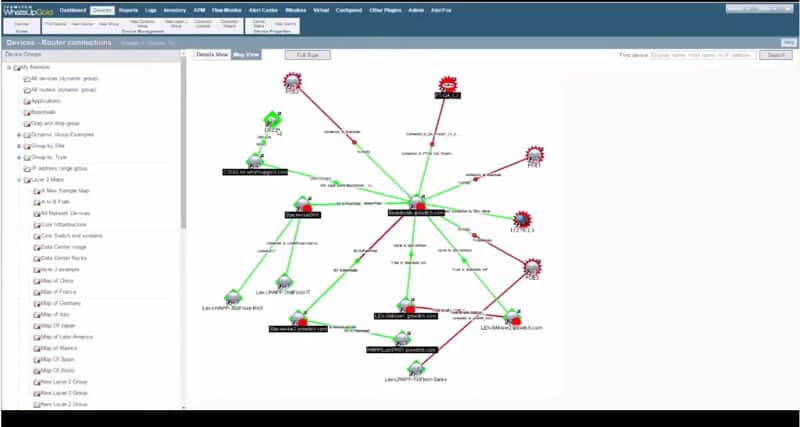
WhatsUp Gold is another main competitor and replacement for Nagios as a server and application monitoring solution. WhatsUp Gold has some nice features and functionality that will prove to be useful in any environment.
The new interface for WhatsUp Gold 2017 has a very simple, uncluttered layout if that's what your looking for. We prefer a more detailed dashboard, but some like very simple and modern dashboards with multiple tabs for other screens.
Key Features:
- Automated Discovery: Quickly discover and map network devices, servers, and applications to streamline monitoring setup.
- Network Traffic Analysis: Monitor and analyze network traffic to identify bandwidth usage patterns and potential bottlenecks.
- VM Monitoring: Gain insights into virtual machine performance and availability to ensure optimal virtualization infrastructure operation.
- Application & Server Performance Monitoring: Monitor the performance and availability of critical applications and servers to proactively detect and resolve issues.
Why do we recommend it?
Progress WhatsUp Gold emerges as a formidable competitor and potential replacement for Nagios, offering robust server and application monitoring solutions. With its intuitive interface and comprehensive feature set, WhatsUp Gold simplifies monitoring tasks and provides valuable insights into network and application performance. While it may lack native support for importing Nagios scripts, WhatsUp Gold compensates with its user-friendly interface and extensive monitoring capabilities.
We dug around to see if we could find some information in regards to importing or converting existing Nagios scripts into WhatsUp Gold, but could not find anything on this package either.
Take a look at their official website for more information and details;
Download WhatsUp Gold Today and Give it a Test Drive:
https://www.ipswitch.com/forms/free-trials/whatsup-gold
We've highlighted Several good Nagios alternatives along with Screenshots and Feature sets. In our eyes, Solarwinds Server and Application Monitor is the clear winner due to its Native Nagios Script Import functionality which really helps you get the Monitoring system migrated over Very quickly – even within Minutes!
Who is it recommended for?
WhatsUp Gold is recommended for organizations seeking an intuitive and feature-rich server and application monitoring solution. It caters to users who prefer a simple and modern dashboard layout, making it suitable for both novice and experienced administrators. Additionally, WhatsUp Gold's support for automated discovery, network traffic analysis, and VM monitoring positions it as a versatile solution for businesses of all sizes and industries.
Pros:
- Intuitive Interface: WhatsUp Gold boasts a simple and uncluttered interface, making it easy to navigate and use.
- Wide Device Support: Supports a wide range of flow-enabled devices, ensuring comprehensive network monitoring capabilities.
- Versatile Deployment: Compatible with both virtual and physical hardware, providing flexibility in deployment options.
- Balanced User Experience: Strikes a balance between user experience and monitoring features, catering to the needs of diverse user groups.
Cons:
- Windows Compatibility: Limited to Windows operating systems, restricting deployment options for users preferring other platforms.
- Resource Limitations: The free version of WhatsUp Gold restricts monitoring to only five resources, potentially limiting scalability for larger environments.
With a 30-Day Free Trial and their Support channels and User forums, they've really taken the necessary steps to set themselves apart from their Competitors.
Open-Source
These are a few of the nagios alternatives that seem to be fitting for Paid solution, there are also an abundance of Open-source replacements that make moving away from nagios less painful and potentially cheaper.
5. Zabbix
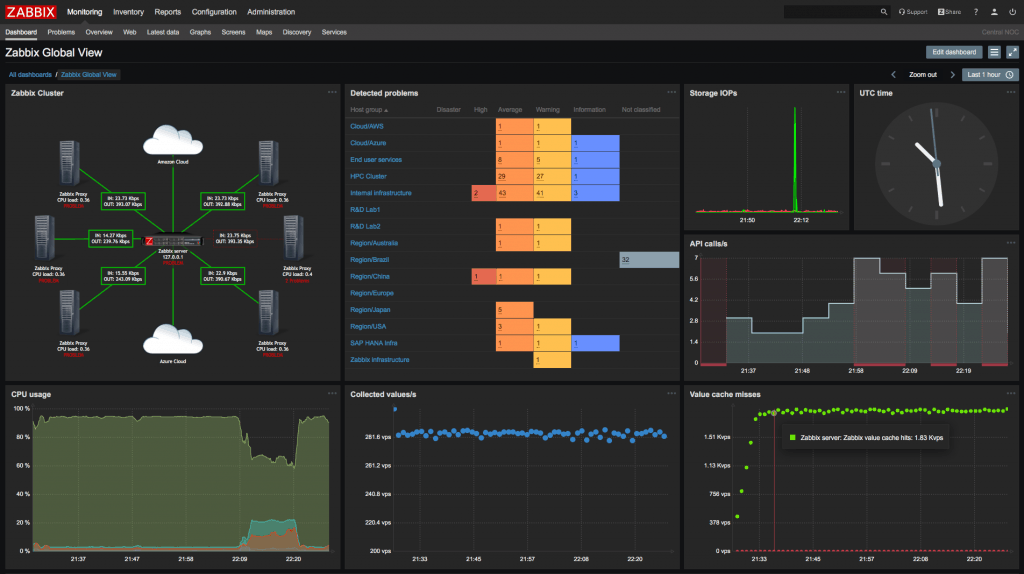
Zabbix is a Great solution if your looking for an open-source alternative. They have really been stepping up their game lately and their interface has changed so much over the years that its worth looking into.
Key Features:
- Multiple Platform Agents: Supports monitoring across different systems with platform-specific agents, ensuring comprehensive coverage.
- SNMP & IPMI Monitoring: Utilizes SNMP and IPMI monitoring agents for broad monitoring ranges and seamless integration with network devices and hardware.
- Agentless Monitoring: Enables agentless monitoring of user services, providing flexibility in monitoring approach and reducing resource overhead.
- Custom Data Collection: Allows for the creation of custom methods for collecting data, enabling tailored monitoring solutions to meet specific requirements.
- Web Monitoring & New UI: Offers end-user web monitoring capabilities and a modern user interface for enhanced user experience and usability.
Why do we recommend it?
Zabbix earns our recommendation for its robust feature set, open-source transparency, and continuous improvements, making it a reliable choice for organizations seeking a flexible monitoring solution. With support for multiple platform agents, SNMP, and IPMI monitoring, Zabbix offers versatility in monitoring various systems and services. Its agentless monitoring capabilities and custom data collection methods further enhance its adaptability to diverse monitoring requirements. Additionally, Zabbix's commitment to community-driven development ensures transparency and fosters innovation, contributing to its reputation as a leading open-source monitoring platform.
Who is it recommended for?
Zabbix is recommended for organizations of all sizes seeking a customizable and cost-effective monitoring solution. It caters to IT professionals, system administrators, and enthusiasts who value open-source transparency and community-driven development. While lacking a paid support option, Zabbix is ideal for small to medium-sized enterprises looking to avoid vendor lock-in and reduce monitoring costs. Additionally, its versatile feature set makes it suitable for a wide range of industries and monitoring scenarios, from network infrastructure monitoring to application performance monitoring. Overall, Zabbix is a valuable choice for those seeking a powerful and flexible monitoring platform with extensive customization options.
Pros:
- Open-Source Transparency: Zabbix's open-source nature allows for transparency and community-driven development, fostering innovation and flexibility.
- Versatile Monitoring: Utilizes SNMP and ICMP for broader monitoring ranges, ensuring comprehensive coverage of network devices and services.
- Useful Templates: Provides useful templates for quick insights and simplified monitoring configuration, reducing setup time and effort.
Cons:
- Lack of Paid Support Option: Zabbix does not offer a paid support option, which may be suboptimal for large enterprise environments requiring dedicated support services and SLAs.
6. OpenNMS
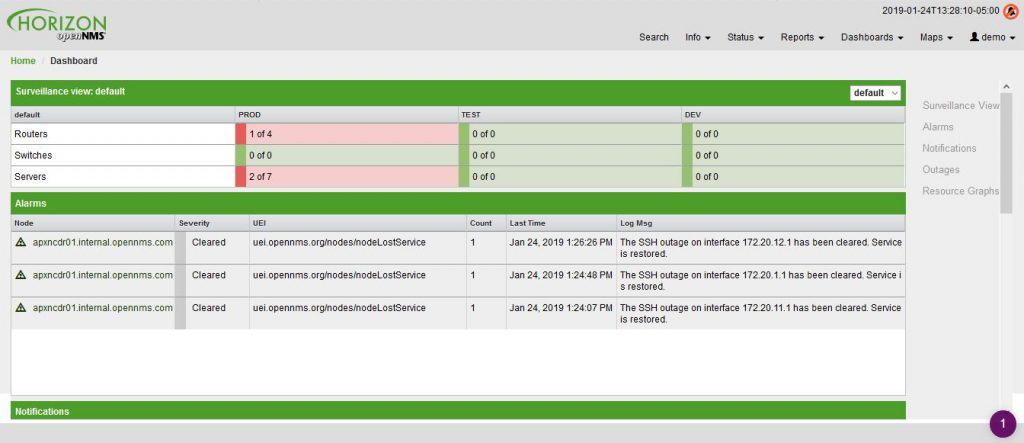
OpenNMS is another great open-source monitoring tool that really stands out from the other open-source competitors as they have partnered with some larger companies to ensure intergration and support is as seemless as possible.
Key Features:
- Seamless Integration: OpenNMS offers seamless integration with various systems and services, including Citrix XenApp, Apache, Asterisk, and more.
- Extensive Documentation: Users benefit from a wealth of documentation resources, facilitating easy implementation and troubleshooting.
- Stable & Beta Versions: OpenNMS provides both stable and beta versions, allowing users to choose between reliability and access to cutting-edge features.
- Versatile Monitoring Options: With a wide range of monitoring options, OpenNMS ensures comprehensive monitoring coverage tailored to specific needs.
- Flexible Alert Notifications: Users can configure flexible alert notifications to stay informed about critical events and system status changes.
Why do we recommend it?
OpenNMS earns our recommendation for its extensive support for monitoring solutions and systems, making it a versatile choice for organizations with diverse monitoring needs. The partnership with larger companies ensures seamless integration and robust support, enhancing the reliability of the platform. OpenNMS's commitment to open-source principles fosters a community-driven development model, resulting in continuous innovation and adaptability to evolving monitoring requirements. Additionally, the availability of both stable and beta versions provides users with options to choose between reliability and access to cutting-edge features. With ample documentation and a wide range of monitoring options, OpenNMS offers users the flexibility and customization they need to tailor their monitoring environment to their specific needs.
They also support a wide variety of monitoring solutions and system including some of the following:
- Citrix XenApp
- Apache with the HTTP collector
- Asterisk (PBX)
- exim
- GDataAntiVir Services
- Microsoft AD Services
- Microsoft Exchange
- Microsoft Standard Services
- Microsoft Windows Remote Desktop Session Host servers
- Microsoft Windows Update Services (WSUS) servers
- MySQL
- MySQL with the HTTP collector
- Nginx with the HTTP collector
- PostgreSQL OpenNMS DB
- Symantec Backup Exec
- VMware Tools
- MSSQL
- Tomcat 5.5 JMX How-To
Who is it recommended for?
OpenNMS is recommended for organizations and individuals seeking a comprehensive open-source monitoring solution with extensive customization options. It caters to IT professionals, system administrators, and enthusiasts who value community-driven development and open-source transparency. While users may need to rely on help documents and forums for support, OpenNMS is ideal for those willing to invest time in exploring its features and contributing to the community. With support for a wide variety of monitoring solutions and systems, OpenNMS is suitable for organizations of all sizes and industries looking for a flexible and adaptable monitoring platform.
Pros:
- Customization & Add-ons: OpenNMS offers extensive customization options and supports personalized add-ons, allowing users to tailor the tool to their unique requirements.
- Abundant Documentation: The tool provides ample documentation resources, aiding users in implementation and troubleshooting processes.
- Stable & Beta Versions: Users have the option to choose between a stable version and a beta test version, ensuring access to both reliability and cutting-edge features.
- Wide Range of Monitoring Options: OpenNMS supports a diverse range of monitoring solutions, catering to various system and service requirements effectively.
- Flexible Alert Notifications: Users can configure flexible alert notifications, enabling timely responses to critical events and system issues.
Cons:
- Reliance on Community Support: Users may encounter delays in issue resolution as they rely on community forums and help documents for support, which might not always provide immediate solutions.
Nagios Alternatives FAQs
Is Nagios the best monitoring tool?
Nagios is a very strong system monitoring package but its ability to compete in both the free and paid system monitoring market is frequently challenged. The free tool is very comprehensive. However, the Nagios team has taken away the traffic analysis functions from this, moving them off into a separate paid tool, which puts Nagios Core at a disadvantage when compared to other free system monitors. Nagios XI is only available for Linux, which puts it at a disadvantage when competing for sales because many businesses are Windows-only and so would need to run the Nagios monitoring system over a hypervisor. Probably the biggest threat to Nagios’s market share is the movement of the major rival systems to the Cloud – a move that Nagios isn’t making. The major strength of Nagios lies in the large library of free plug-ins that are provided by Nagios Exchange.
Which is better Nagios vs zabbix?
Zabbix is a very strong competitor to Nagios and its development is very encouraging. Zabbix is completely free to use, which makes it a competitor to Nagios Core. Zabbix beats Nagios in the free monitoring market because it has a good frontend, which Nagios Core lacks and it also provides NetFlow monitoring, which isn’t present in Nagios Core – that is a separate paid module with Nagios. Nagios XI is a more comprehensive package than Zabbix. However, comparing a paid tool with one that is a free tool, you would expect better functionality from a system that earns money.
Is Nagios obsolete?
Nagios covers both the free and paid monitoring system markets and it has a very loyal user community. The concept of this tool being obsolete is probably generated by the rivals of the monitoring package rather than its users.
